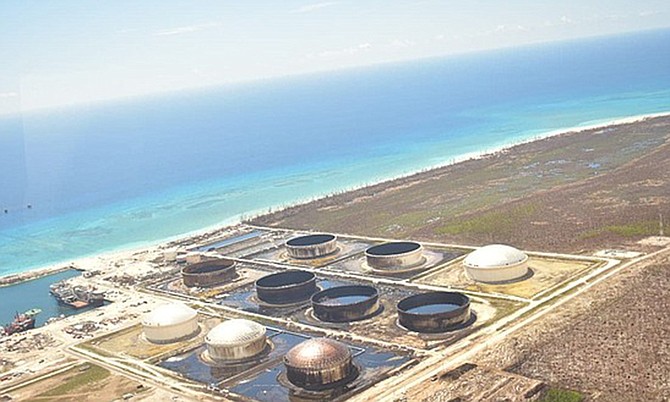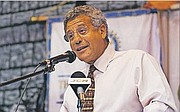By Frederick Smith, Q.C.
On August 31 Hurricane Dorian slammed into Grand Bahama, ravaging the landscape, devastating communities and tearing lives apart. It destroyed thousands of homes and businesses, ruined vital infrastructure and left so many families grieving for their loved ones.
The monster storm also hit the Equinor oil bunkering facility head on. Five million gallons of oil were spilled, poisoning the delicate ecosystem for seven miles north of the facility and no doubt polluting the underground water supply in the process. Though it has been downplayed by both the Government of The Bahamas and the Norwegian company, [and nary a whisper from the Grand Bahama Port Authority responsible for our water supply] this is a major disaster and the long-term consequences for the environment, and the health and safety of the population, are likely to be severe.
Serious questions abound regarding the role of Equinor.
Was Equinor really as prepared for a major natural disaster as it should have been? Has our government ever inspected or supervised its maintenance and or disaster preparedness protocols? Were the tanks built and maintained according to international standards? Why doesn’t the Bahamas even have its own standards? Was there an up-to-date emergency response plan in place, and if so, why did it take so long to mobilise a meaningful clean-up operation?
If the oil spilled over the top of the tanks, as is claimed by Equinor, how and why did two of the tanks remain full to the brim throughout the storm, despite having their lids torn off like the others? Is Equinor absolutely sure that a breach of one or more tank hulls was the real cause of the spill? And if so, what would it mean for Equinor’s liability?
ASSESSING EQUINOR’S PERFORMANCE
A Category 5 hurricane brings extremely powerful forces to bear upon physical structures. Nevertheless, the roof of each tank should have been designed to withstand such wind force, particularly in light of the fact the tanks are in an environmentally sensitive area and GB is in Hurricane Alley.
The tank roofs must and should have been able to withstand 200mph plus winds.
Some of the tanks were only half full. This probably prevented additional spillage, however, if there had been more storm surge, these half-filled tanks would have collapsed. To negate this risk, as the hurricane approached the tanks should have either been filled to capacity with oil, or better yet, emptied and filled with water. Neither approach was taken by Equinor.
Once the crude oil has spilled, a clean-up and restoration process must be initiated immediately. As late as September 8, there was no evidence that clean-up had commenced. When work did begin, it was sparse and not in accordance with international best practices. The Ministry of Environment only reported on September 18 that international clean-up crews had arrived on-site and said that only “one goat and three birds” were impacted.
On September 12, Save The Bays president Joseph Darville visited the site and noted a number of Bahamians were engaged in clean-up exercises without having been issued any protective gear.
The Health and Safety at Work Act, passed decades ago, has never been enforced for the protection of industrial workers in Grand Bahama. The company has since denied that any workers were in danger.
What does our Government say about this?
The Equinor tank farm is located in an environmentally sensitive location and in reality should have never been built there, especially in a country that experiences frequent hurricanes. No matter how strong the tanks are made, there is always a danger they will rupture and that collapse will occur, causing severe damage to both the onshore and aqueous ecosystems and endangering the human population.
And for what benefit? How much taxes are earned from Equinor by the people of the Bahamas to expose them to this risk of irreversible toxic and hazardous disaster?
Taking into account the high risk of having any oil processing or storage facility at this location (particularly the environmentally sensitive east side of the island), the Equinor facility must be strengthened and the secondary containment must be improved significantly. Removing the facility entirely would really be the best option.
WHERE THE BUCK STOPS
At the end of the day though, we cannot expect to rely on the good will of foreign corporations to protect our interests. They will only do as much as they are made to do by the authorities. And so the buck stops with our political leaders.
The real story in this human and environmental tragedy is: How could any government of The Bahamas have allowed oil bunkering facilities to be established in the first place, in the absence of an Environmental Protection Act that gives regulators real teeth? Currently, there are no protocols for prior planning for a disaster, no rules for maintenance of such a facility and no mandatory disaster management plan.
Given these circumstances, it is no surprise the government was paralysed, caught like a deer in the headlights, by this dangerous spill. When responding to a disaster, time is of the essence and the days it took to mobilise any kind of cleanup effort in this case will dictate how much damage has been done to the underground water supply, the pine forests, the wetlands. All of which could have been prevented.
PLANNING FOR THE FUTURE
Finally Parliament is getting ready to debate a suite of Environmental Protection Bills. Before doing so, MPs should pause and make sure that the many lessons of Hurricane Dorian are reflected in the legislation.
For example, as regards oil spills, the law should include both Spill Prevention, Control, and Countermeasure (SPCC) regulations and a Facility Response Plan (FRP). An SPCC helps facilities prevent a discharge of oil into navigable waters or adjoining shorelines. An FRP requires facilities to submit a response plan and prepare to respond to a worst-case oil spill or threat of an oil spill.
The SPCC regulations should cover two types of secondary containment requirements: general and specific. General secondary containment requirements should address the most likely oil discharge from a facility; specific secondary containment requirements should address a major container or tank failure.
All facilities must be required to meet the general secondary containment requirements, while bulk storage containers and tanks should also meet the specific containment requirements. All areas of all facilities with the potential for oil discharge should be required to be designed with appropriate containment or diversionary structures to prevent harmful discharges.
A good model for current SPCC and FRP regulations is provided by the United States Environmental Protection Agency (EPA). For petroleum products, the most-widely recognised and instructive standard on secondary containment in the United States code NFPA 30, the Flammable and Combustible Liquids Code. This code provides that Class I through Class IIIA liquids (liquids with flash points below 200 degrees F, including most petroleum liquids other than heavy fuel oils) shall be contained in the event of a spill or rupture, and that the volume of the containment system be large enough to hold the contents of the largest tank. It further specifies that the containment area be constructed of earth, steel, concrete or solid masonry designed to be liquid-tight.
Finally, tank owners should bear the financial responsibility of spills and be required to respond to and mitigate a worst-case discharge of oil or other hazardous substances.
THE SPECTRE OF OBAN
In the wake of the Equinor spill, Grand Bahama is haunted by the spectre of Oban. The $5 billion oil refinery proposal for East Grand Bahama cannot in all good conscience be allowed to move forward in light of what has happened.
While Equinor is at least a reputable international oil company with a public image to uphold, Oban appears to be a wildly opportunistic venture whose principals have little experience in operating complex facilities such as refineries. Hopefully the spill has opened government’s eyes to the risk they would be taking with the island’s fragile ecosystems and finite water supply, were they to sign off on this foolhardy proposal.
In fact, it would be better for The Bahamas to get out of the oil business on the whole.
Around the world, fossil fuels are declining as a source of primary energy, from 29 percent of world primary energy use today, to a projected 17 percent in 2050.
This reduction is largely due to the rapid electrification of the world’s road transportation fleet. In aviation and shipping, biofuels will drive de-carbonisation. Oil is expected to peak in 2022 and fall off sharply from there.
In light of this, it would only make strategic sense for Grand Bahama, and the country in general, to begin to change its relationship with oil bunkering and refining facilities, and evolve its energy policy to focus on investing in renewables instead.
But will this ever happen, given that politicians at the highest echelon‘s of both the PLP and the FNM have historically been the dominant investors in the oil supply business in The Bahamas?
This should also be the case when it comes to production of the domestic energy supply, which should move to incorporate solar and other renewable options as soon as possible.
Certainly, the government should cease granting approval to all potentially hazardous industrial projects until the current proposed suite of environmental Bills is amended to take into account the lessons learned from Hurricane Dorian, and then passed by Parliament.
Finally, Grand Bahama, the industrial capital of the country, should have its own fully staffed and equipped Department of Environmental Health and Safety, Freeport its Environmental Health and Safety Bye Laws and Department together capable of both aiding in disaster response and ensuring that all such facilities adhere to the standards set out in the laws.
It’s time The Bahamas grows up and takes its responsibilities seriously if it wants to play on the industrial world stage.






Comments
Porcupine 4 years, 5 months ago
"It’s time The Bahamas grows up and takes its responsibilities seriously if it wants to play on the industrial world stage". Mr. Smith, Bahamians will grow up. In 2 or 3 more generations, when most all Bahamians are living elsewhere because this country will be mostly underwater, with only the highest points visible. There is a very real cost to placing all of our hopes and wishes with a supreme being and taking almost no responsibility for our own lives. Hence, children are having children. Our educational levels are childish. Laws are made for other people. The government will provide for me. I can go to work when I want. I can take what I want. The list goes on. But, to grow up and take responsibilities seriously. Get serious. What is ever taken seriously here? Be honest.
proudloudandfnm 4 years, 5 months ago
Ya'll need to get Oban out of your head, that was never an actual project, it was always ONLY a speculation exercise, they never planned to build, they planned to sell what they have as a turn-key op complete with all approvals.
What we need to be pushing government for now is to ensure both Stat Oil and BORCO's tanks are brought up to par. BORCO's tanks look to be the exact same as Stat's. Government needs to step in and push them both to upgrade their tanks immediately and to document and upgrade their procedures to prevent and manage a spill.....
Sickened 4 years, 5 months ago
What is the government going to fine them? $1 billion? More?
TheMadHatter 4 years, 5 months ago
"...international standards? Why doesn’t the Bahamas even have its own standards? Was there a..."
WHY should we have our OWN standards???????? International standards already exist. We should follow them in stead of reinventing the wheel.
Perhaps Mr. Smith wants to hand over control of our oil operations to Haiti?
Sign in to comment
Or login with:
OpenID